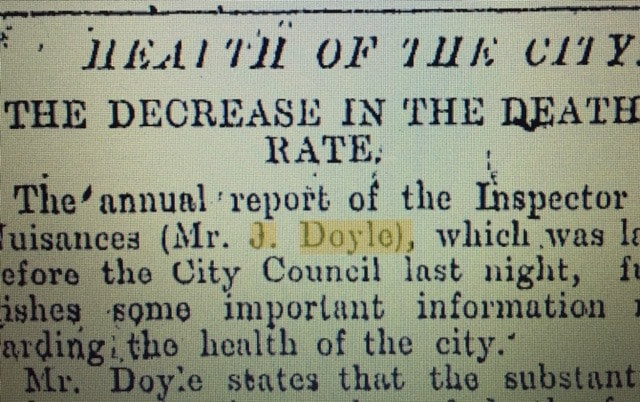|
Do you think you have a rubbish job?
Spare a thought for the men who held the title of Inspector of Nuisances to various councils around New Zealand. Great title aside, they literally dealt with the rubbish of a city. Started in Britain, they were a type of sanitation and environmental health inspector, expected to deal with everything from dead animals in the street, night soil and a weird array of other problems. A quick search in Wellington City Archives and newspapers at the time show a vast number of complaints about things like horrible smells, dog taxes, unsanitary premises, gorse, cow sheds, loitering fruit sellers and even a case of leprosy. And proving that Wellington traffic problems have been around forever, the increase of motorcars and the speeds they traveled. (The first cars in New Zealand were imported into Wellington.) What a job huh? One of these men was James Joseph Doyle. Born in Williamstown, Australia in 1852 he came to New Zealand in 1868 attracted by gold but ended up in Wellington in 1879 where he went into the police force. He left the police in 1895 to become a muscular temperance lecturer for six months but then rejoined the police. Doyle became Inspector of Nuisances to the Wellington City Council, a role he developed into that of chief sanitary officer. He held the role until 1922. His term is marked by the reforms he made. Especially in regards to the prevalence of typhoid fever, an ever present threat. He is credited with helping prevent deaths. He was the first to suggest setting up municipal abattoirs and the need for a pure milk supply. At one point in his career in 1900 he was doing inspections for bubonic plague. He prosecuted people for selling diseased meat and in one annual report was able to happily report that spitting on the sidewalk had decreased probably due to a £20 fine. He was noted for literally sniffing out problems. He was also a noted athlete, a runner and heavyweight lifter. Mr Doyle died aged 76 in 1926 after serving his city loyally for many years. Flags on the municipal buildings were flown at half mast for him. He is buried at Karori Cemetery. With thanks to Wellington City Archives for their amazing resource.
0 Comments
Leave a Reply. |
AuthorFran and Deb's updates Archives
May 2025
Categories |

 RSS Feed
RSS Feed